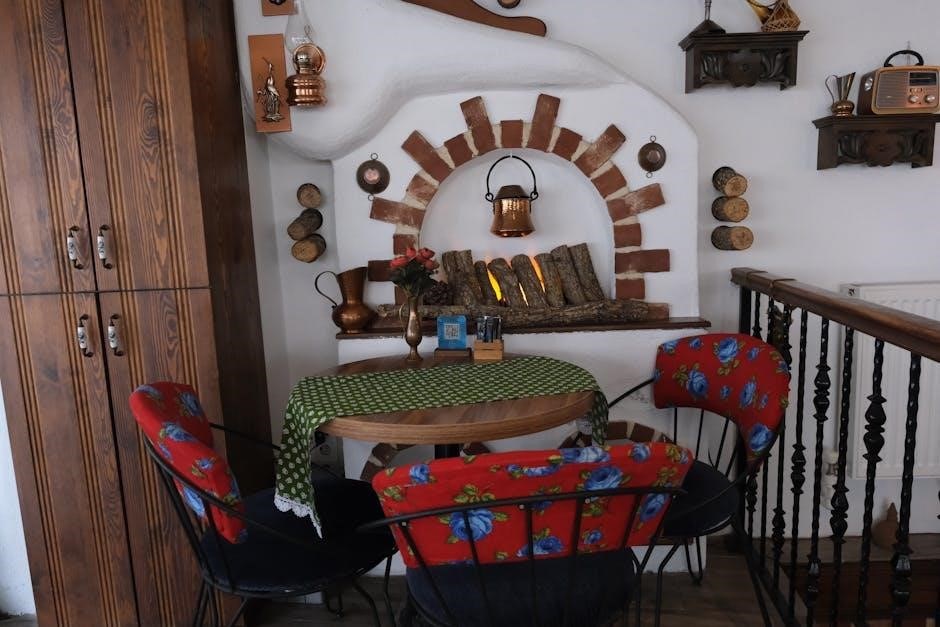Selecting the right round dining table involves understanding size‚ seating capacity‚ and space requirements. This guide helps you choose the perfect table for your dining area.
Understanding the Importance of Proper Sizing
Proper sizing ensures your round dining table fits seamlessly into your space‚ balancing comfort and functionality. A table that is too small may feel cramped‚ while one that is too large can restrict movement. Consider chair width (17-20 inches) and leave adequate space for comfortable seating and traffic flow. Standard table heights (28-30 inches) pair well with most chairs‚ but adjustments may be needed for taller or shorter seating. Measuring your room and understanding seating needs helps avoid a table that disrupts the flow or feels out of scale. Proper sizing enhances both the aesthetic and practicality of your dining area.
Key Considerations for Choosing a Round Dining Table
When selecting a round dining table‚ prioritize room size‚ seating needs‚ and chair dimensions. Measure your space to ensure the table fits comfortably‚ leaving at least 36 inches around for easy movement. Consider the number of diners; a 36-inch table seats 4‚ while a 48-inch table accommodates 6. Chair width (17-20 inches) impacts overall space requirements. Table height should match chair height for comfort‚ typically 28-30 inches. Material and style also play a role‚ with options like wood or metal offering durability and aesthetic appeal. Balancing these factors ensures a functional and inviting dining area tailored to your lifestyle.

Standard Round Dining Table Sizes
Standard round dining tables range from 36 to 72 inches in diameter‚ accommodating 4 to 8 people. Heights typically remain consistent at 28-30 inches for comfort.
Common Diameter Measurements
Round dining tables typically range in diameter from 36 to 72 inches‚ with common sizes including 36-44 inches for 4 people‚ 44-54 inches for 4-6 people‚ and 54-72 inches for 6-8 people. These measurements ensure comfortable seating and adequate space for dining. Standard diameters are designed to fit various room sizes and seating needs‚ making round tables versatile for small or large gatherings. Proper sizing ensures functionality and aesthetics‚ creating a balanced dining environment.
Table Height and Chair Compatibility
Standard dining table height is typically 28-30 inches‚ complementing most chairs. Chair height‚ measured from floor to seat‚ plus 5-6 inches‚ determines ideal table height. Counter-height tables (34-36 inches) and bar-height tables (40-42 inches) require matching stools. Ensuring compatibility between table and chair height is crucial for comfort and functionality‚ avoiding awkward seating arrangements. Proper alignment enhances dining experiences‚ making it essential to consider chair dimensions when selecting a table height.
Room Size and Seating Capacity
Room size and seating capacity are crucial when choosing a round dining table. A 36-44 inch table accommodates 4 people‚ while 44-56 inches suits 6‚ and 54-72 inches fits 8. Measure your space to ensure comfort‚ leaving at least 36 inches around the table for movement. Larger tables in small rooms can feel cramped‚ so balance size with space for a functional and inviting dining area. Proper scaling ensures a harmonious setup‚ making meals enjoyable for everyone. Plan accordingly to maximize comfort and flow in your dining room.
Measuring Round Dining Tables
Measuring round dining tables focuses on diameter‚ the primary dimension. Ensure the table fits your space by calculating diameter and allowing ample room for chairs and movement.
Diameter as the Primary Measurement
The diameter is the key measurement for round dining tables‚ determining seating capacity and space requirements. Standard diameters range from 36 inches (seating 4 people) to 72 inches (seating 8 people). A 44-inch table comfortably seats 4-6 people‚ while a 54-inch table suits 6-8 people. Larger diameters provide more space but may overwhelm smaller rooms. Ensure the table’s diameter aligns with your room’s dimensions and seating needs for a balanced setup. Proper measurement ensures comfort‚ ease of movement‚ and a functional dining area tailored to your lifestyle and space constraints.
Calculating Space for Comfortable Seating
When calculating space for a round dining table‚ consider both the table’s diameter and chair width. Standard dining chairs are 17-20 inches wide‚ so add 2-3 feet to the table’s diameter for comfortable seating. Ensure at least 36 inches of clearance around the table for easy movement. Measure your room’s dimensions to confirm the table fits without overcrowding. Proper spacing ensures a functional and inviting dining area‚ allowing guests to sit and move comfortably. This balance of size and space creates a harmonious setup for everyday meals or special occasions.
Considering Chair Width and Table Size
Chair width plays a crucial role in determining the ideal round dining table size. Standard dining chairs measure 17-20 inches in width‚ so ensure the table’s diameter accounts for this. A general rule is to add 2-3 feet to the table’s diameter to provide ample space for chairs and comfortable seating. For example‚ a 48-inch table (4 feet) should have a total footprint of 6-7 feet‚ including chair space. Measure your chairs to confirm dimensions and select a table size that balances seating capacity with room aesthetics. Proper proportions ensure a functional and inviting dining setup.
Seating Capacity Guide
A round dining table’s seating capacity depends on its size. A 36-44″ table seats 4‚ 44-56″ seats 6‚ and larger tables accommodate 8 or more for gatherings.
Table Size for 4 People
A round dining table for 4 people typically measures between 36 and 44 inches in diameter. This size is ideal for small families or intimate gatherings‚ providing ample space for plates‚ utensils‚ and conversation..Tables in this range are compact yet comfortable‚ fitting well in cozy dining areas without feeling cramped. For added comfort‚ ensure at least 24 inches of space per person‚ and consider chair width when calculating overall room layout. This size strikes a balance between practicality and elegance‚ making it a versatile choice for everyday use or casual entertaining.
Table Size for 6 People
A round dining table for 6 people typically measures between 44 and 56 inches in diameter. This size is ideal for medium-sized families or occasional entertaining‚ offering enough space for plates‚ utensils‚ and conversation. Tables in this range provide comfortable seating for six adults‚ with each person having about 24 inches of personal space. Ensure the room allows for at least 36 inches of clearance around the table for easy movement. This size balances functionality and aesthetics‚ making it a popular choice for many households. Pair it with standard dining chairs to create a cohesive and inviting dining area.
Table Size for 8 People
A round dining table for 8 people typically measures between 60 and 72 inches in diameter. This size comfortably accommodates 8 adults‚ with each person having about 24 inches of personal space. Tables in this range are ideal for larger families or frequent entertainers. Ensure the room provides at least 36 inches of clearance around the table for easy movement. This size strikes a balance between ample seating and a spacious dining area‚ making it perfect for formal gatherings or everyday use. Pair it with chairs that complement its scale for a harmonious setup.

Optimizing Traffic Flow
Ensure smooth movement by leaving at least 36 inches of clearance around the table‚ allowing comfortable passage and easy access to seating areas‚ enhancing functionality and flow.
Minimum Space Requirements Around the Table
To ensure smooth traffic flow‚ leave at least 36 inches of clearance around the table. This allows comfortable movement and easy access to seating. In smaller rooms‚ 30 inches may suffice‚ but this can feel cramped. For larger spaces‚ 42 inches or more creates a spacious‚ inviting atmosphere. Proper clearance prevents overcrowding and enhances the dining experience. Measure the room carefully to balance table size with surrounding space‚ ensuring a harmonious and functional layout for everyday use or entertaining guests.
Creating a Cohesive Dining Area
A well-designed dining area starts with a round table that complements the room’s dimensions and decor. Pair the table with chairs that match its style and scale. Consider the room’s shape—round tables work especially well in square rooms‚ creating balance. Add lighting‚ rugs‚ and decor that reflect your personal style. Ensure the table’s size leaves enough space for movement and conversation. By harmonizing furniture and layout‚ you create a welcoming atmosphere perfect for meals and gatherings‚ making the dining area the heart of your home.
Positioning the Table in the Room
Positioning a round dining table effectively enhances both functionality and aesthetics. Place the table in the center of the room for a balanced look‚ ensuring equal access for all diners. Consider the room’s dimensions to avoid overcrowding. Leave at least 36 inches of clearance around the table for comfortable seating and movement. In smaller spaces‚ position the table away from walls to maintain traffic flow. For visual appeal‚ align the table with a focal point‚ like a window or fireplace. Proper placement creates a harmonious and inviting dining environment‚ making meals more enjoyable and the space feel cohesive.
Chair and Table Size Compatibility
Ensure chairs fit comfortably under the table by considering standard chair widths (17-20 inches) and adjusting table height to match chair dimensions for optimal comfort.
Standard Chair Dimensions
Standard dining chairs typically measure 17 to 20 inches in width and 29 to 33 inches in height‚ including the backrest. Seat heights usually range from 18 to 20 inches from the floor. Armrests‚ if present‚ add about 2-3 inches to the overall height. These dimensions ensure compatibility with most dining tables‚ including round ones. Chair size directly impacts seating comfort and table placement‚ so measuring chairs is essential when choosing a table. Proper alignment between chair and table height ensures a comfortable dining experience‚ with enough legroom and clearance for movement.
Adjusting Table Height for Different Chairs
Table height should complement chair dimensions for optimal comfort. Measure chair height from floor to seat cushion‚ then add 5-6 inches for standard dining tables (28-30 inches). For counter-height chairs (34-36 inches tall)‚ use a table of 34-36 inches. Bar-height chairs (40-42 inches) require a table of 40-42 inches. Ensure legroom by maintaining 12 inches between seat and tabletop. Proper alignment prevents strain and enhances dining comfort. Adjusting table height based on chair size ensures a harmonious and functional setup‚ catering to various preferences and room designs.
Ensuring Comfortable Seating Arrangements
Comfortable seating begins with chair width and table clearance. Standard dining chairs are 17-20 inches wide‚ requiring 12 inches of clearance between the chair and table edge. Larger tables accommodate more space‚ ensuring guests aren’t cramped. Consider extendable tables for flexibility. Measure your room to ensure adequate space around the table‚ allowing 36-42 inches for traffic. Place chairs 24-30 inches apart for easy conversation. These guidelines ensure a balanced and ergonomic dining setup‚ prioritizing guest comfort without compromising style or functionality;

Round vs. Other Table Shapes
Round tables offer versatile seating and space efficiency‚ ideal for small areas‚ while rectangular and square tables provide more surface area for larger gatherings and formal settings.
Comparing Round‚ Square‚ and Rectangular Tables
Round tables are ideal for small spaces and foster conversation‚ while square tables offer versatility for small groups. Rectangular tables provide more surface area and suit formal settings. Round tables are perfect for cozy gatherings‚ square tables work well in compact rooms‚ and rectangular tables accommodate larger families or events. Each shape has unique spatial benefits‚ with round tables promoting intimacy‚ square tables balancing functionality‚ and rectangular tables emphasizing tradition. Choose based on your room size‚ seating needs‚ and desired ambiance to create a harmonious dining experience.
Advantages of Round Tables in Small Spaces
Round tables are a practical choice for small spaces due to their space-efficient design. They fit seamlessly into tight areas‚ offering more room for movement around the table. Circular shapes also create a sense of intimacy‚ making conversations easier among all guests. Additionally‚ round tables visually enhance small rooms by eliminating sharp corners‚ creating a more open feel.
Their compact footprint allows for comfortable seating without overwhelming the space. Round tables are also versatile‚ suiting both casual and formal settings. With various size options‚ they can accommodate small gatherings while maintaining a modern aesthetic. Choosing the right size ensures functionality and style in limited spaces.
Visual Appeal and Versatility
Round dining tables offer timeless elegance and versatility‚ complementing various interior styles. Their smooth‚ curved edges create a modern aesthetic while softening the ambiance of a room. Unlike square or rectangular tables‚ round shapes eliminate sharp corners‚ fostering a more inviting atmosphere. This design versatility allows round tables to blend seamlessly into both formal and casual settings‚ making them a popular choice for diverse decor preferences. Additionally‚ their circular form creates a balanced visual appeal‚ enhancing the overall harmony of a dining space while accommodating guests comfortably.

Material and Style Considerations
Round dining tables come in various materials like wood‚ metal‚ and glass‚ each offering unique durability and design. Styles range from modern to traditional‚ ensuring versatility.
How Material Affects Table Size and Design
The choice of material significantly influences the size and design of a round dining table. For instance‚ solid wood tables are often larger and more robust‚ suitable for traditional settings‚ while metal or glass tables are sleek and modern‚ ideal for smaller spaces. The material also impacts durability and weight‚ affecting how the table fits into the room. A glass tabletop‚ for example‚ can create a sense of openness‚ making the space feel larger‚ whereas a wooden table adds warmth and texture. Additionally‚ materials like steel or reclaimed wood offer unique aesthetic advantages‚ shaping the overall design.
Modern vs. Traditional Round Table Styles
Modern and traditional round dining tables differ in design‚ material‚ and aesthetic appeal. Modern tables often feature sleek lines‚ minimalist designs‚ and innovative materials like glass or metal‚ creating a contemporary look. Traditional tables‚ on the other hand‚ emphasize classic details‚ such as ornate carvings or rich wood finishes‚ evoking timeless elegance. The choice between styles depends on personal preference and room decor. While modern tables are ideal for smaller spaces‚ traditional ones often accommodate larger gatherings with their robust build. Both styles offer versatility‚ allowing seamless integration into various dining environments while maintaining functionality and beauty.
Customizing Your Round Dining Table
Customizing your round dining table allows you to tailor its design to fit your unique space and style. From material choices like wood‚ metal‚ or glass to finishes such as polished‚ matte‚ or distressed‚ you can create a table that reflects your aesthetic. Additional features like extendable leaves or built-in storage offer practical solutions for varying needs. Personalize further with custom dimensions‚ ensuring the table complements your room’s proportions. Whether modern or traditional‚ a customized round dining table enhances functionality and visual appeal‚ making it the centerpiece of your dining area while accommodating your lifestyle and preferences perfectly.
Practical Tips for Choosing the Right Size
Measure your dining room‚ consider chair size‚ and ensure adequate seating capacity. Leave space for traffic flow and future needs when selecting your round dining table size.
Measuring Your Dining Room

Start by measuring the length and width of your dining room in inches. Note any obstructions‚ such as doorways or windows‚ to ensure proper placement. Consider the table’s diameter and add 36 inches for seating and movement. Measure chair widths (17-20 inches) to ensure comfort. Account for extendable tables‚ if applicable. Plan for future needs‚ like additional seating or changing decor. Use masking tape to mark potential table sizes on the floor for a visual guide. Accurate measurements ensure a well-fit table that complements your space and enhances functionality.
Considering Extendable Table Options

Extendable round dining tables offer flexibility for varying guest numbers. Measure the room to ensure the table‚ when extended‚ fits comfortably. Consider the extended diameter‚ as it impacts seating capacity. For example‚ a 44-inch table may extend to 60 inches‚ seating up to eight. Check the extension mechanism (e.g.‚ butterfly or leaf) and ensure it suits your space. Extendable tables are ideal for entertaining while maintaining a compact footprint in smaller rooms. Always verify the table’s stability when extended and ensure adequate clearance for chairs and movement. This option balances practicality with aesthetic appeal.
Thinking About Future Needs
When selecting a round dining table‚ consider future needs to ensure long-term satisfaction. Assess potential changes in household size or entertaining frequency. A table that accommodates future guests without overwhelming the space is ideal. If planning a family‚ opt for a slightly larger table‚ such as a 54-inch diameter‚ which can seat up to eight. Additionally‚ consider the table’s material and style to ensure it remains timeless. Planning ahead avoids the need for future replacements‚ making your choice both practical and enduring. This foresight ensures your dining table remains functional and beautiful for years to come. Always measure your space and chair dimensions to ensure compatibility.
Choosing the right round dining table involves balancing size‚ seating needs‚ and space; By following this guide‚ you’ll find a table that enhances your dining experience for years to come.
Final Thoughts on Selecting the Perfect Round Dining Table
Selecting the ideal round dining table requires careful consideration of size‚ seating capacity‚ and room dimensions. Measure your space‚ choose a diameter that accommodates your needs‚ and ensure chair compatibility. Opt for a table height of 28-30 inches for standard chairs‚ or adjust if using taller or shorter seating. Consider extendable options for flexibility and future needs. Finally‚ think about the visual appeal and style that aligns with your interior design. By balancing functionality and aesthetics‚ you’ll create a welcoming dining area that enhances daily meals and special gatherings alike.
Recap of Key Size and Measurement Guidelines
Round dining tables are measured by diameter‚ with standard sizes ranging from 36 to 72 inches. A 36-44 inch table seats 4‚ while 44-54 inches accommodates 4-6 people‚ and 54-72 inches seats 6-8. Table height typically ranges from 28-30 inches‚ pairing well with standard chairs (17-20 inches wide). Ensure at least 36 inches of clearance around the table for comfortable movement. Chair size and room dimensions are crucial for optimal fit. Always measure your space and consider future needs when selecting the perfect round dining table for functionality and aesthetics.
